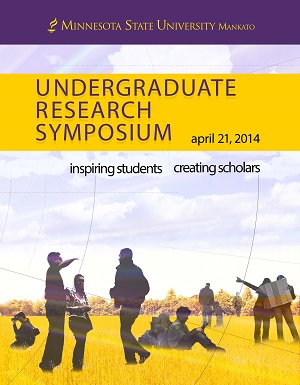Biofilm Formation by Escherichia coli csgA and fimA mutants
Location
CSU Ballroom
Start Date
21-4-2014 10:00 AM
End Date
21-4-2014 11:30 AM
Student's Major
Biological Sciences
Student's College
Science, Engineering and Technology
Mentor's Name
Timothy Secott
Mentor's Email Address
timothy.secott@mnsu.edu
Mentor's Department
Biological Sciences
Mentor's College
Science, Engineering and Technology
Description
Biofilms are a structured community of bacterial cells enclosed in a self-produced polymeric matrix and adherent to an inert or living surface. These structures and the organisms that cause them can pose a very serious problem if they colonize on medical devices. This is because biofilms have the ability to communicate within the colony and with other organisms that might attach to the surface, acting like a community working together. Biofilms allow the organism to be resistant to harsh and unfavorable conditions allowing them to survive longer and spread. Several genes in Escherichia coli have been associated with biofilm formation by that organism. Many of those genes encode surface appendages such as flagella, fimbriae, and pili. We created mutations in genes encoding curli (csgA) and fimbriae (fimA) with the aim of comparing their ability to form biofilms. The respective genes were disrupted with a kanamycin resistance gene and selected on kanamycin-containing agar. Biofilm formation in nutrient-rich medium and minimal medium is currently in progress, and the ability of the mutant E. coli strains to form biofilms will be compared with that of the parent wild type strain using a crystal violet microplate assay.
Biofilm Formation by Escherichia coli csgA and fimA mutants
CSU Ballroom
Biofilms are a structured community of bacterial cells enclosed in a self-produced polymeric matrix and adherent to an inert or living surface. These structures and the organisms that cause them can pose a very serious problem if they colonize on medical devices. This is because biofilms have the ability to communicate within the colony and with other organisms that might attach to the surface, acting like a community working together. Biofilms allow the organism to be resistant to harsh and unfavorable conditions allowing them to survive longer and spread. Several genes in Escherichia coli have been associated with biofilm formation by that organism. Many of those genes encode surface appendages such as flagella, fimbriae, and pili. We created mutations in genes encoding curli (csgA) and fimbriae (fimA) with the aim of comparing their ability to form biofilms. The respective genes were disrupted with a kanamycin resistance gene and selected on kanamycin-containing agar. Biofilm formation in nutrient-rich medium and minimal medium is currently in progress, and the ability of the mutant E. coli strains to form biofilms will be compared with that of the parent wild type strain using a crystal violet microplate assay.
Recommended Citation
Snyder, Nicole and Sean Willaert. "Biofilm Formation by Escherichia coli csgA and fimA mutants." Undergraduate Research Symposium, Mankato, MN, April 21, 2014.
https://cornerstone.lib.mnsu.edu/urs/2014/poster_session_A/28




